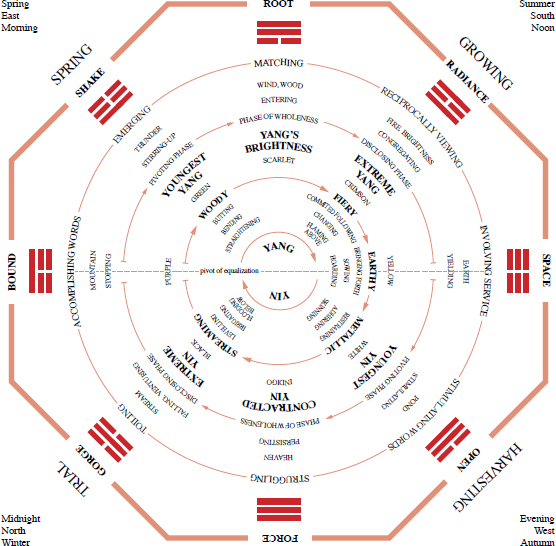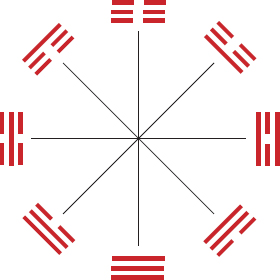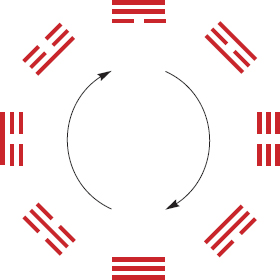
4 | Correlative Thinking
The world view embodied in the Yijing is essentially different from the linear, causal perspective prevalent in our Western thinking. It is based on a system of correlations whose essential features took shape in the Han epoch and were codified by the Discussions in the White Tiger Hall in 79 CE.48Everything under heaven can be assigned to a specific phase in a system of interlocked, correlated cycles. The intrinsic dynamics of all phenomena is therefore represented in this system, which is the foundation of all Chinese traditional science. Its logic has been well described by Joseph Needham:
The key-word in Chinese thought is Order and above all Pattern (and, if I may whisper it for the first time, Organism). The symbolic correlations or correspondences all formed part of one colossal pattern. Things behaved in particular ways not necessarily because of prior actions or impulsions of other things, but because their position in the ever-moving cyclical universe was such that they were endowed with intrinsic natures which made that behavior inevitable for them . . . They were thus parts in existential dependence upon the whole world-organism. And they reacted upon one another not so much by mechanical impulsion or causation as by a kind of mysterious resonance.49
The words of the Yijing acquire their full range of meaning when they are understood in this context. The fundamental cycles and their interrelations are displayed in the following diagram, called the Universal Compass. This diagram is repeated at the end of the book for ease of reference.

THE UNIVERSAL COMPASS
(See I Ching: The Classic Chinese Oracle of Change, 1994)
The cycles represented in the diagram are:
• the cycle of yin and yang
• the yearly and daily solar cycles and the quadrant of the four directions
• the cycle of the eight trigrams
• the cycle of the five Transformative Moments
The five Transformative Moments (Woody, Fiery, Earthy, Metallic and Streaming) became prominent among various other correlative systems at the beginning of the Han era. While in earlier thought they still retained some characteristics of material substances, in Han cosmology they came to represent moments of all processes in general, phases of the cyclical change of all things on various time scales. (That is why we avoid the misleading term “elements,” which is sometimes used in this context, and we use the adjectival form instead of the nouns “Wood, Fire, Earth, Metal, Water.”) The Discussions in the White Tiger Hall developed a vast system of correspondences based on the five Transformative Moments, embracing all kinds of natural and social processes.
An outstanding problem of this system was how to harmonize the base five cycle of the Transformative Moments with the base two cycles of yin and yang, four seasons, four directions and eight trigrams. The solution adopted by Han cosmologists consisted in viewing the Earthy Moment as the support of all the others and giving it a special location. There are various versions of this special placement: the one adopted in this book is the arrangement described in the Huainanzi, which makes the Earthy Moment coincide with the Pivot of Equalization, i.e. with the boundary between the yang and the yin hemicycles.
The center of the diagram symbolically corresponds to the axis of heaven and earth: it is the axis around which all cycles rotate, the unmoving center of all motions. All processes, actions, qualities and symbols lined up on the same radius are correlated with each other. This correlation is a sort of resonance, similar to that which exists between strings or bells vibrating with the same frequency: even though they may not be in direct contact with each other, when one of them is activated, the others enter into vibration.
Placing the eight trigrams of the Yijing in the context of this cosmological system vastly expands their meaning. The locations of the upper (or outer) and of the lower (or inner) trigram of your hexagram in the Universal Compass are especially meaningful. Some of their correlations are summarized in the Outer and Inner Trigram section of each hexagram. All the resonances that are relevant for your specific question or situation, or that call up a particular emotional response in you, can be included in your answer.
Like the daily cycle, the yin–yang cycle is articulated in two hemicycles, separated by an axis called Pivot of Equalization, where the two principles balance each other. Each hemicycle starts with a Pivoting Phase, the first movement toward the predominance of yin or yang; it develops into a Phase of Wholeness, in which each principle fully expresses its qualities; and it culminates in a Disclosing Phase, in which yin or yang becomes extreme and breaks out of boundaries, thus starting its own decline and restoring the balance of the Pivot of Equalization.
The yearly cycle and the four directions
Superposed on the yin–yang cycle we find in the Universal Compass the yearly cycle and the quadrant of the four directions. Four basic divinatory terms in the Yijing correspond to the seasons of the year and to the four directions. We find them already in the Image of the Situation of the first hexagram:
Spring, Growing, Harvesting, Trial.
“Spring” refers to the vernal season, and is associated with East and with sunrise. It represents the beginning, the source, the primal originating power which causes things to emerge from the ground.
“Growing” refers to summer, and is associated with South and with noon. It represents vigorous life, completion, success, the power which brings to maturity what has sprouted in Spring.
“Harvesting” refers to autumn, and is associated with West and with sunset. It represents benefit, nourishment, the power which harvests the fruit that has ripened in Growing, both reaping and gathering.
“Trial” refers to winter, and is associated with North and with midnight. It represents a test, an ordeal, the power which separates what survives the winter from what decays and dies, the lasting from the perishable; it denotes the act of divination itself, which separates valid from worthless, right from wrong.
The five Transformative Moments
The yin–yang cycle, the daily and yearly cycle and the quadrant of the four directions interlock with the cycle of the Five Transformative Moments. As we have previously remarked, these categories are not material substances, but moments or phases of all processes, aspects of the dynamic change of things in general.
The Woody Moment, associated with spring, East and sunrise, begins the cycle. It describes organic growth, typically a young sprout breaking through the crust of the earth: its actions are butting, bending and straightening.
Wood is fuel for fire. Therefore the Fiery Moment follows, associated with summer, South and noon. It describes combustion, glowing and upward motion. The flame remains joined to the wood out of which it arises and gradually changes it into ashes: its actions are committed following, flaming above and changing.
Ashes, or soil, correspond to the Earthy Moment, associated with the Pivot of Equalization, with the transition from yang to yin and vice versa. It is the support of all the other Moments. Its actions are bringing-forth, sowing and hoarding.
The extraction of minerals from the earth brings about the Metallic Moment, associated with autumn, West and sunset. It describes crystallization, concen -tration, the hard forms of cast metal, the consolidated structures of yin. Its actions are those of the metallurgic art: restraining, adhering and skinning.
Melting liquefies solid metallic forms, giving rise to the Streaming Moment, associated with winter, North and midnight. It describes all moving fluids and par -ticularly water. Its actions are leveling, flooding below and irrigating. By seeping into the soil of the Pivot of Equalization, this water causes wood to grow, starting a new cycle.
THE EIGHT TRIGRAMS AND THEIR ATTRIBUTES
Each trigram of the Yijing has a name, a symbol, a specific action and a position in a family structure:
| TRIGRAM | NAME | SMBOL | ACTION | FAMILY ORDER |
 |
Energy | Heaven | Persisting | Father |
 |
Space | Earth | Yielding | Mother |
 |
Shake | Thunder | Stirring-up | Eldest son |
 |
Gorge | Stream | Venturing, Falling | Middle son |
 |
Bound | Mountain | Stopping | Youngest son |
 |
Root | Wood, Wind | Entering | Eldest daughter |
 |
Radiance | Fire, Brightness | Congregating | Middle daughter |
 |
open | Pond | Stimulating | Youngest daughter |
THE EIGHT TRIGRAMS AND THEIR ATTRIBUTES
The eight trigrams can be arranged in a cyclical order in two main ways. The older one is called the Sequence of Earlier Heaven or the Primal Arrangement. It is traditionally attributed to Fuxi and it reflects a cosmic order prior to the human world. In it the trigrams form simple pairs of opposites at the ends of each diameter:

SEQUENCE OF EARLIER HEAVEN (FUXI’S ARRANGEMENT)
The other cyclical order is called the Sequence of Later Heaven or the Inner World Arrangement. This one is attributed to King Wen and it applies to the human world we inhabit and to its natural cycles:

SEQUENCE OF LATER HEAVEN (KING WEN’S ARRANGEMENT)
This rather more intricate arrangement is spelled out in the Shuogua, Discussion of the Trigrams, the Eighth Wing of the Yijing, and it is the one that is incorporated in the system of the Universal Compass. The Shuogua says:
The Supreme [manifests] in the Shake by emerging, in the Root by matching, in the Radiance by reciprocally viewing, in Space by involving service, in the Open by stimulating words, in Energy by struggling, in the Gorge by toiling, in the Bound by accomplishing words.50
The Shake corresponds to the first emergence of yang: a yang line enters from below, arousing the energies of the seed sleeping in the earth. It is the time of emerging, associated with spring, East, sunrise and the beginning of the Woody Moment.
The Root corresponds to the wholeness of yang and to the full development of the Woody Moment, which brings matching, coupling and multiplying.
The Radiance corresponds to extreme yang, associated with summer, South, noon and the Fiery Moment. It is the bright light which allows beings to view each other.
Space corresponds to the southwestern pole of the Pivot of Equalization and to the Earthy Moment. It is the time of agricultural works and involving service.
The Open corresponds to the beginning of the yin hemicycle, to autumn, West, sunset and to the first phase of the Metallic Moment. It is the time of harvest, bringing joyous and stimulating words.
Energy corresponds to the wholeness of yin, where structures have reached their most consolidated form, and a dissolving tendency begins to be felt. It is a time characterized by the struggle between these two opposing tendencies.
The Gorge corresponds to extreme yin, to winter, North, midnight and the Streaming Moment. The tendency to dissolution now prevails. The darkness of winter brings trial and toiling to a life cycle nearing its end.
The Bound corresponds to the northeastern pole of the Pivot of Equalization and marks the end of the cycle. At the end of winter, life comes to a still point, suspended between death and rebirth. This time is characterized by accomplishing words, which articulate what is ending and prepare the beginning of a new cycle.